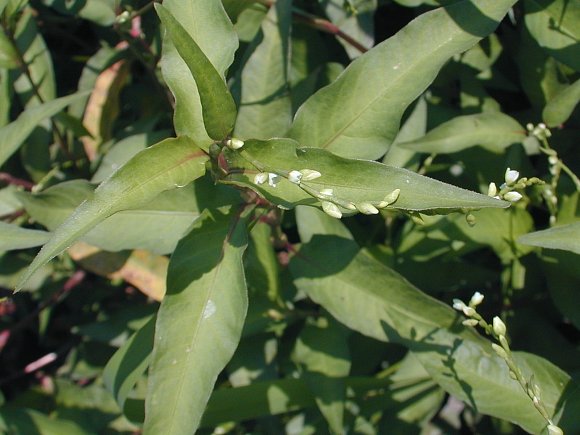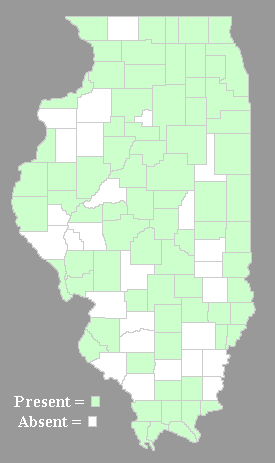Description: This plant is a summer annual about 1-2' tall, branching occasionally. It has a tendency to sprawl and lean on adjacent plants for support. The hairless stems are green or red (often the latter). The alternate leaves are up to 3½" long ad ¾" across. They are lanceolate, smooth along the margins, and usually hairless. Their upper surface is often olive-green. Each leaf has a short petiole; the base of this petiole has a membranous sheath (an ocrea) that wraps around the stem. This sheath has a few bristly hairs along its upper rim. The sheaths of adjacent leaves on each stem are about 1-2" apart.

The upper stems
terminate in spike-like racemes of flowers that are about 1½–3" long.
These racemes are quite slender and their flowers are sparsely
distributed (or interrupted); they often nod at their tips or droop
sideways, rather than remaining erect like the racemes of other
smartweeds. In addition to these terminal racemes, very short axillary
racemes often develop from the sheaths of the upper leaves. Each
greenish white flower is about 1/8" (3 mm.) long, consisting of 5
sepals, 2-3
styles, 4-6 stamens, and no petals. Each outer sepal is light green
toward its base, becoming white toward its upper edge; rarely are the
outer sepals pink. The green portion of each outer sepal is pitted with
pale yellow glands; these tiny glands usually turn brown when the outer
sepals become dried out (a hand-lens with 10x magnification may be
required to see them). The flowers are shy to open and usually bud-like
in shape. The blooming period occurs from mid-summer to early fall and
lasts about 1-2 months. There is no noticeable floral scent. Each
flower is replaced by a seed that is 3-angled, dull-looking, and black
or dark brown. The root system branches frequently and is rather
shallow and fibrous. This plant spreads by reseeding itself and often
forms colonies.
Cultivation:
The preference is full or partial sun, wet to moist conditions, and a
mucky soil that contains abundant organic material. In disturbed
wetlands, this plant can spread aggressively. It has few problems with
pests and disease, except for Popillia japonica
(Japanese Beetle). This insect is very fond of the foliage of
smartweeds.
Range & Habitat:
Waterpepper is a common plant that occurs in most areas of Illinois.
According to most authorities, it is native to Eurasia, but not North
America; others believe this species has a circumboreal distribution
and it
is native to both Eurasia and North America. Habitats include soggy
openings in woodlands, logged-over woodlands in floodplains, soggy
alluvial meadows, seeps, edges of rivers and ponds, roadside ditches,
and poorly drained areas of fields. Disturbed wetlands are preferred,
although this plant also occurs in higher quality habitats.
Faunal Associations:
The flowers of this smartweed attract few insect visitors. Charles
Robertson observed three species visiting its flowers for nectar: Halictus
rubicundus (a Halictid bee), Exorista mella
(a Tachinid fly), and Polistes fuscatus
(Northern Paper
Wasp). Various insects feed destructively on the foliage and other
parts of Water Smartweed (Persicaria hydropiper) and other smartweeds
(Persicaria spp.). This includes such species as Chaetocnema concinna (Brassy Flea Beetle) and other flea beetles (Disonycha spp.), various weevils (Listronotus spp. & others), Capitophorus hippophaes (Polygonum Aphid) and other aphids, various stink bugs (Euschistus spp. & others), larvae of Acronicta oblinita (Smeared Dagger Moth) and many other moths (see Insect Table
for a more complete list of species). The
seeds of smartweeds, including those of Waterpepper, are an attractive
source of food to waterfowl, rails, and granivorous songbirds (see Bird Table).
The gullets of such waterfowl as the Wood Duck, Northern Pintail, and
Mallard contained measurable amounts of Waterpepper seeds in Illinois
(Havera, 1999). Because of the biting peppery foliage, Waterpepper is
rarely eaten by
mammalian herbivores; livestock reportedly avoid it (Georgia, 1913).
The foliage of
this smartweed species contains an impressive array of acidic
substances,
including formic acid.
Photographic Location:
At the edge of a small river in Meadowbrook Park, Urbana, Illinois.
Comments:
This is one of the many weedy smartweeds in Illinois, which can be
difficult to identify. Waterpepper can be distinguished from other
smartweeds primarily by its racemes of flowers, which have the
following key characteristics: 1) Its racemes are slender with sparsely
distributed flowers, 2) its
racemes are usually nodding or pendulous, rather than erect, 3) there
are usually very short axillary racemes from the sheaths of the upper
leaves, 4) its flowers are usually greenish white (rarely pink), and 4)
the outer sepals of its flowers have tiny glandular pits that are pale
yellow or brown. Other smartweeds lack one or more of these
characteristics.

A native species, Persicaria punctata (Dotted Smartweed) has a similar appearance to Waterpepper, but its racemes of flowers are more erect. Another difference between these two species is the distance between the bases of the leaves on the stems: the leaf bases of Waterpepper are about 1-2" apart, while the leaf bases of Dotted Smartweed are about 2-3" apart. There is another species, Persicaria hydropiperoides (Mild Waterpepper) that is occasionally encountered. The foliage of this species has a mild taste, while the foliage of Water Pepper has a strong taste that is very peppery and produces a burning sensation. The sepals of Mild Waterpepper lack the fine glandular pits of Waterpepper. While the seeds of Waterpepper have a dull dark appearance, the seeds of many other smartweeds are dark, but shiny. Both the scientific name Polygonum hydropiper and common name 'Marshpepper Smartweed' refer to Waterpepper.